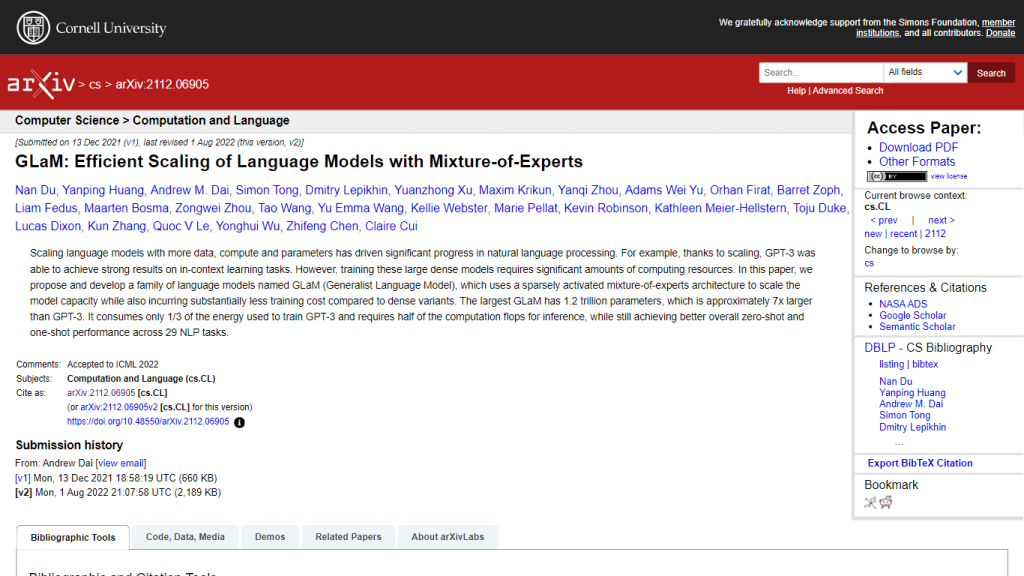What is GLaM?
The Generalist Language Model, GLaM is a family of large language models that applies sparse activation of a mixture of expert systems. This design will enable the GLaM model to scale effectively with much-improved results, thus improving performance with significantly fewer resources in training and inference.
There was a reason, of course, for developing GLaM due to the great resource requirements of large traditional models such as GPT-3. The GLaM architecture could handle as many as 1.2 trillion parameters-seven times as many as in the GPT-3-but with a fraction of the energy and computation required in the latter. As far as scaling up language models is concerned, it is incomparable.
Key Features & Benefits of GLaM
-
Huge Model Capacity:
GLaM represents a model with 1.2 trillion parameters, one of the largest language models built so far. -
Much Greater Efficiency:
This is a truly greener model; training in GLaM requires only a third of the energy consumption compared to GPT-3. -
Less Computational Needs:
Compared to its predecessors, GLaM requires half of the amount of computational flops needed at inference time. -
Best Performance:
GLaM outperformed a new record on zero-shot and one-shot learning on 29 NLP tasks for expected outperformance above GPT-3. -
Original Architecture:
The sparsely activated mixture-of-experts framework turns GLaM much more resource-efficient by having parts of the model activated only when necessary, allowing much more efficiency and improvement in performance.
GLaM Use Cases and Applications
The advanced capability further opens GLaM to several applications across a variety of industries. For example:
-
Customer Support:
GLaM can be used in support platforms to provide fast responses with high precision for better customer satisfaction. -
Content Creation:
GLaM makes it easier for writers and marketers to get high-quality content with minimum consumption of time and energy. -
Education:
These models can also be used within learning platforms for things like personalized learning, finding elaborative answers to even the most complicated questions. -
Medical Diagnosis:
This technology can also be put to work in the medical domain to analyze patients’ data and help diagnose conditions and offer possible treatments.
Indeed, several case studies validate real-world applicability of GLaM and provide attractive results for substantial enhancement of task performance coupled with resource efficiency.
GLaM Usage
How to use GLaM? Using GLaM involves only a few steps described in the sequel.
-
Access Model:
Access API or platform of GLaM. -
Input Data:
Provide relevant input data or prompts on whatever operation you would wish to perform. -
Parameters Setup:
Adjust parameters and settings of the model to your needs. -
Review and Refine:
Go through the results and refine the input or parameters if needed. One recommendation for best usage with respect to GLaM is spending some time to familiarize one’s self with the interface and how to navigate it so that the model capabilities can be used effectively and efficiently.
GLaM Working
GLaM works on a sparsely activated mixture of experts architecture, which is pretty much a big deviation from the previously existing models; each one of them being densely packed. The architecture will do the task by switching on that part of the model which comes into play in order to get a particular job done and hence optimize computational resources for better efficiency.
It does so with the help of advanced algorithms and models that choose between the right “experts” at any given time within the architecture to execute one aspect or another of a given task. Selective activation enhances performance and decreases the overall load on computation.
In practical application, this will mean input into the model; data is followed by the generation of output-accurate and contextually relevant information-by the mixture-of-experts framework.
GLaM Pros and Cons
Like with all technologies, there are merits and probable demerits to GLaM.
Pros
- Unique performance for zero-shot and one-shot learning tasks.
- Much more energy and computationally efficient than GPT-3.
- Highly scalable, having a huge model capacity of 1.2 trillion parameters.
- A novel architecture in which efficiency is optimized.
Cons
- Its mixture-of-experts architecture is rather complex and hence may be hard for new users to get used to.
- Being still relatively new, GLaM may still be facing some limitations to more general adoption and integration.
Feedback from users has largely been positive, touting GLaM’s high performance and efficiency.
Conclusion to GLaM
That is to say, GLaM represents a quantum leap both in the research and engineering of the language model. The sparse-activated mixture-of-experts architecture does not find its equal in efficiency and performance; therefore, it is worth using for many applications.
While the technology is yet evolving, we should expect even further improvements and updates that will make GLaM stand apart in leading a class of language models. GLaM is recommended to anyone looking for an efficient, powerful, and scalable NLP solution.
GLaM FAQs
What is a GLaM model?
The GLaM model stands for Generalist Language Model-a family of language models that use a sparsely activated mixture-of-experts architecture to make the model more efficient and performant.
How does GLaM compare to GPT-3 in parameters?
GLaM is 1.2 trillion parameters, roughly seven times bigger than GPT-3.
What are some advantages with the GLaM’s mixture-of-experts architecture?
This architecture enables much higher model capacity by using more efficiently only parts of the model at any given time, reducing overall computational needs.
How does GLaM fare compared to GPT-3 for NLP tasks?
Among these, both zero-shot and one-shot learning, GLaM outperforms GPT-3 on 29 NLP tasks.
Energy and computation savings: What does that bring to GLaM?
GLaM requires one-third as much energy consumption and uses half of the computational flops during inference compared to GPT-3.










